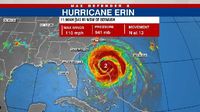As the Atlantic hurricane season enters its peak, Hurricane Erin has emerged as a formidable presence, threatening the U.S. East Coast and prompting widespread warnings and preparations. On August 20, 2025, Erin was churning in the western Atlantic, located at 30.1N and 73.7W—about 365 miles south-southeast of Cape Hatteras, North Carolina—with maximum sustained winds of 110 mph, according to both FOX 13 and WFLA, citing the National Hurricane Center (NHC).
Erin, classified as a Category 2 hurricane, was moving north at approximately 13 mph. Meteorologists noted that the storm’s trajectory would bring it closer to the North Carolina coast by Wednesday evening, with its outer bands expected to worsen weather conditions there. The NHC forecasted that Erin would turn toward the north and north-northeast through Wednesday night, followed by a faster motion toward the northeast and east-northeast on Thursday and Friday. The center of the hurricane was predicted to pass over the western Atlantic, remaining between the U.S. East Coast and Bermuda through early Friday, before veering south of Atlantic Canada on Friday and Saturday.
This projected path meant that coastal communities from North Carolina to New Jersey were squarely in the storm’s sights. A tropical storm warning was in effect along this stretch, and evacuation orders were issued for parts of the North Carolina Outer Banks, where tropical storm conditions were expected late Wednesday. The NHC also announced a Storm Surge Warning from Cape Lookout to Duck, North Carolina, and a Tropical Storm Warning from Beaufort Inlet, North Carolina to Chincoteague, Virginia, including the Pamlico and Albemarle sounds. Bermuda, too, was placed under a Tropical Storm Watch, with tropical storm conditions possible there on Thursday and Friday.
For residents and vacationers along the U.S. East Coast, the warnings were clear and urgent. The NHC advised beachgoers against swimming at most beaches due to life-threatening surf and rip currents generated by Hurricane Erin. These hazardous conditions were expected to persist for several days, as the storm’s powerful winds and waves battered the coastline. According to FOX 13, strong waves and dangerous rip currents were already being reported, and officials were urging caution and compliance with local advisories.
In a twist of meteorological fate, the Tampa Bay area in Florida experienced a reprieve from the usual August deluges. FOX 13 Meteorologist Dave Osterberg explained that Hurricane Erin was pulling moisture away from the region, resulting in a significant drop in rain coverage—just 20% on Wednesday and 30% on Thursday. Temperatures, however, remained high, with Tampa expected to reach about 94 degrees. While the lack of rain was a welcome break for some, it also underscored the reach and influence of a major hurricane, even when it remains hundreds of miles offshore.
As for Erin’s strength, forecasters were keeping a close eye on the storm’s potential for intensification. Wind shear had limited Erin’s development on Tuesday, but both FOX 13 and WFLA reported that some strengthening was possible over the next day or so. However, the NHC anticipated that weakening would likely begin by Friday, as the hurricane moved further north and encountered less favorable conditions. Despite this, Erin was forecasted to remain a hurricane into the weekend, maintaining its status as a significant threat to maritime and coastal interests.
Beyond Hurricane Erin, the Atlantic basin was showing signs of heightened activity. The NHC was monitoring two additional tropical waves, both of which had the potential to develop into named storms. The first, located over the central tropical Atlantic, was producing showers and thunderstorms and had a 60% chance of development within the next seven days. Environmental conditions appeared conducive for gradual organization, and a tropical depression could form later in the week or over the weekend as the system approached the northern Leeward Islands. The chance of formation within the next 48 hours was lower, at 10%.
The second area of interest, dubbed Invest 99L, was situated southwest of the Cabo Verde Islands. While it lacked a closed surface circulation as of Wednesday, there was still a 40% chance of development within both the next 48 hours and seven days. The system was moving westward at about 15 mph, but the NHC noted that environmental conditions were expected to become less favorable for further development by the end of the week. Even so, these disturbances were being closely tracked, as August and September are historically the most active months of the Atlantic hurricane season.
For communities along the East Coast, the approach of Hurricane Erin has brought a familiar mix of anxiety and preparation. Emergency officials in North Carolina, Virginia, and New Jersey urged residents to heed evacuation orders and review hurricane preparedness plans. In the Outer Banks, where evacuation orders were in effect, local authorities coordinated transportation and sheltering efforts to assist those needing to leave low-lying areas. In Bermuda, residents and businesses were advised to secure property and monitor updates from local meteorological services as the storm’s outer bands approached.
Meanwhile, meteorologists emphasized the importance of staying informed. The NHC and local news outlets like FOX 13 and WFLA provided frequent updates on Erin’s position, strength, and projected path. The public was encouraged to sign up for hurricane guides, newsletters, and alerts to ensure they had the latest information at their fingertips. As one meteorologist put it, “Be prepared, not scared.”
Historically, August storms like Erin have proven unpredictable, sometimes intensifying rapidly or shifting course in ways that catch even seasoned forecasters off guard. The lessons of past hurricanes—Florence, Dorian, and others—loom large in the collective memory of coastal communities. This year, with multiple systems brewing in the Atlantic, the sense of vigilance is especially acute.
As Erin continues its trek northward, all eyes remain on the Atlantic. The coming days will determine whether the storm delivers a glancing blow or a more direct impact to the U.S. coastline and Bermuda. With additional tropical systems waiting in the wings, the 2025 hurricane season is shaping up to be a busy one, demanding attention, preparation, and resilience from all those in its path.
For now, the message is clear: heed the warnings, stay informed, and respect the power of nature. The Atlantic, as ever, is reminding everyone that hurricane season is far from over.




